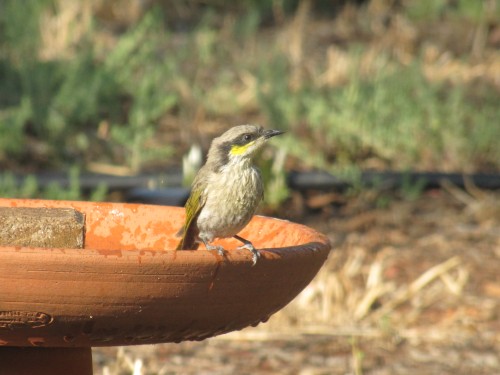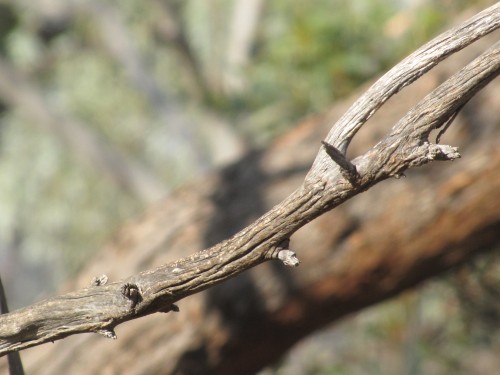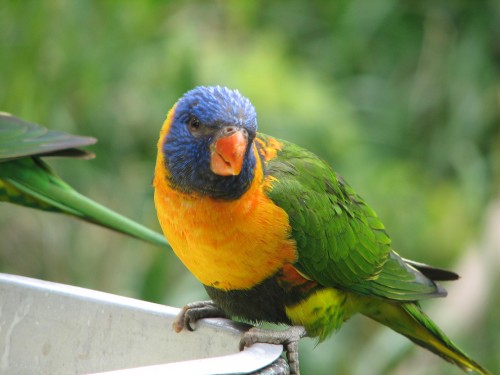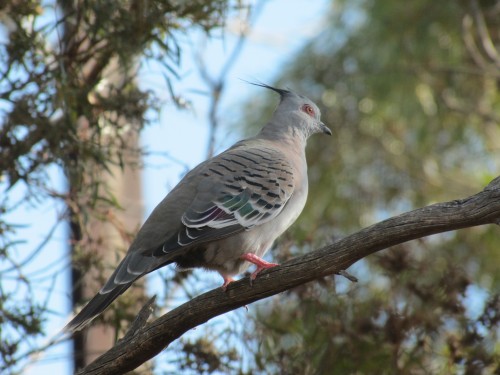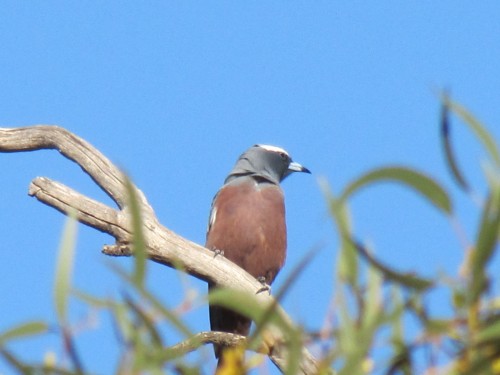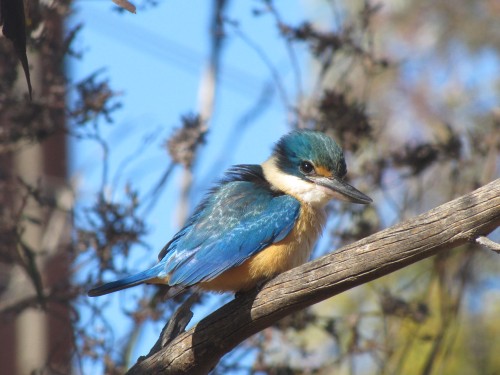Singing Honeyeater at the bird bath
Over recent days I have shared some of the photos of birds seen during our recent hot spells of weather. Our bird baths are popular with the resident bird population and we can observe anything up to a dozen species in a ten minute period. Bird Bath Central can get both busy – and noisy.
One of the quieter species to come for a drink would have to be the Singing Honeyeater. They come individually – and occasionally in twos and threes – and never make a great fuss. certainly not like the gregarious New Holland Honeyeaters. I have observed that they tend to come when no other birds are around. The much larger Red Wattlebirds and Australian Magpies are the usual dominant birds, bossing the other species away.
And then we get those interesting birds like that not shown in the photo below. Sometimes the birds are just too quick for my camera. I must make a collection of photos of rocks, twigs, branches and fence posts showing where a bird has just been – but escaped before the shutter was released.
Bird photography
Photos on this site
I must admit that this site would be much poorer and quite uninteresting for readers without the photos I include with most of my posts. The vast majority of the articles I post here are illustrated by at least one photo; sometimes as many as 4 or 5. In fact, the photos I take are usually the reason for posting an article, that is, the words result from the photos taken.
Early photographic attempts
In my early years of birding I bought a cheap SLR camera which took reasonable scenery photos, all in 35mm slide format. This was in the pre-digital era, the 1980s. I also invested in a telephoto lens in order to take bird and wildlife photos, along with a cumbersome tripod. The results were mixed – many taken with the telephoto lens were poor and mostly unusable here. (As an aside, my son has recently completed scanning all of these early slides into digital format. I plan to use the best of them on this site later in the year.)
First digital camera
In the late 1990s I acquired my first digital camera, a very basic Kodak point and shoot. It gave me a renewed enthusiasm for photography. I can’t remember much about the details of this camera, but a little research found the user’s manual to the Kodak Easyshare CX4200 digital camera which was a 2megapixel point and shoot. It only had a 2x digital zoom, virtually useless for bird photography.
Canon SX2 IS
In 2005 I was preparing to go trekking in Nepal. I upgraded to a Canon Powershot SX2 IS. This was a huge jump forward because now I had 12x optical zoom and 5megapixals to play with. It was lightweight, easy to use and took some fabulous photos of the Himalayas. It also opened up many possibilities for bird and wildlife photography. It was about then that this bird site commenced.
Canon SX20 IS
In 2011 my wife and I were preparing for another overseas holiday, this time in Ethiopia, Morocco and Spain. While the main purpose was to visit our daughter who was teaching in Ethiopia, it was also highly focussed on doing the tourist thing. Bird photography was not the main aim; any birds seen and photographed along the way was an incidental bonus.
Well before the trip I upgraded to a Canon SX20 IS and my wife took over the SX2. Between us we managed about 8000 photos in six weeks, including some great bird shots. The 20x optical (plus 4x digital making it effectively 80x) zoom on my new camera gave me so much more flexibility and is proving its worth almost every day while taking photos in our garden, and around our district. I am planning several more major caravanning trips this year, and these will always be where I can get more bird photos.
And as an added bonus, the camera is perfect for taking great shots of my two grandchildren, age 4 and 17 months.
An excellent article
Yesterday I came across an excellent article on using point and shoot cameras for bird photography. Interestingly, the author also uses the Canon SX50 which has a great 50x zoom. Mmm.. I wonder if my wallet can stand another assault? I almost feel the need to upgrade. You can read the article Birding with a point and shoot camera here.
Further reading:
- How to be a birder part 14 – part of a series I wrote some years ago
- How to be a birder – index of the whole series
- I have a new camera – first impressions of the Canon SX20
Yellow-billed Kites in flight, Addis Ababa
With so many Yellow-billed Kites soaring around the school grounds at Bingham Academy in Addis Ababa, I was able to get some good photos over the fortnight we stayed there with our daughter. I always take opportunities to hone my photographic skills but realise that shooting birds in flight is one area I’ve not fully mastered yet. On this post I show three shots of the kites in flight, and while they are not brilliant, I am quite pleased with them, acknowledging that I still have a long way to go in developing this skill.
Do I need a camera?
Frequently asked questions about birding #13
Do I need a camera when I go birding?
No.
But I guarantee you will be saying “If only I had a camera” far too many times.
I carry a small camera bag containing a small digital camera when I go birding. They are so small, light and easy to use. I’ve got so many wonderful photos over recent months that it has totally renewed my interest in photography.
A word of warning: always take spare batteries. I had a wonderful opportunity to take a photo of a rare bird once and the batteries died just a few minutes before. I now carry TWO sets of spare batteries! I’m a slow learner.
Update November 2013:
Since writing this article I have taken many thousands of photos, both here in Australia and overseas. I have included the best of them on this site. Browse through the archives for articles which might interest you; most have at least one photo. Below is a selection of just a few.
